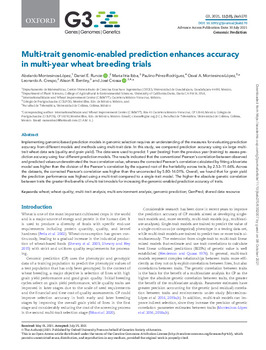Mostrar el registro sencillo del ítem
Multi-trait genomic-enabled prediction enhances accuracy in multi-year wheat breeding trials
| Creador: | Montesinos-Lopez, A. |
| Creador: | Runcie, D.E. |
| Creador: | Ibba, M.I. |
| Creador: | Perez-Rodriguez, P. |
| Creador: | Montesinos-Lopez, O.A. |
| Creador: | Crespo Herrera, L.A. |
| Creador: | Bentley, A.R. |
| Creador: | Crossa, J. |
| Año: | 2021 |
| URI: | https://hdl.handle.net/10883/21696 |
| Lenguaje: | English |
| Editor: | Genetics Society of America |
| Copyright: | CIMMYT manages Intellectual Assets as International Public Goods. The user is free to download, print, store and share this work. In case you want to translate or create any other derivative work and share or distribute such translation/derivative work, please contact CIMMYT-Knowledge-Center@cgiar.org indicating the work you want to use and the kind of use you intend; CIMMYT will contact you with the suitable license for that purpose |
| Tipo: | Article |
| Lugar de publicación: | Bethesda, MD (USA) |
| Número: | 10 |
| Volumen: | 11 |
| DOI: | 10.1093/g3journal/jkab270 |
| Palabras Claves: | Multi-Trait Analysis |
| Palabras Claves: | Multi-Environment Analysis |
| Palabras Claves: | Genomic Prediction |
| Palabras Claves: | Shared Data Resources |
| Descripción: | Implementing genomic-based prediction models in genomic selection requires an understanding of the measures for evaluating prediction accuracy from different models and methods using multi-trait data. In this study, we compared prediction accuracy using six large multi-trait wheat data sets (quality and grain yield). The data were used to predict 1 year (testing) from the previous year (training) to assess prediction accuracy using four different prediction models. The results indicated that the conventional Pearson's correlation between observed and predicted values underestimated the true correlation value, whereas the corrected Pearson's correlation calculated by fitting a bivariate model was higher than the division of the Pearson's correlation by the squared root of the heritability across traits, by 2.53-11.46%. Across the datasets, the corrected Pearson's correlation was higher than the uncorrected by 5.80-14.01%. Overall, we found that for grain yield the prediction performance was highest using a multi-trait compared to a single-trait model. The higher the absolute genetic correlation between traits the greater the benefits of multi-trait models for increasing the genomic-enabled prediction accuracy of traits. |
| Agrovoc: | WHEAT |
| Agrovoc: | QUALITY |
| Agrovoc: | GENOMICS |
| Agrovoc: | DATA |
| Datasets relacionados: | https://hdl.handle.net/11529/10548572 |
| ISSN: | 2160-1836 |
| Revista: | G3: Genes, Genomes, Genetics |
| Número de artículo: | jkab270 |
Ficheros en el ítem
Este ítem aparece en la(s) siguiente(s) colección(ones)
-
Genetic Resources
Genetic Resources including germplasm collections, wild relatives, genotyping, genomics, and IP -
Wheat
Wheat - breeding, phytopathology, physiology, quality, biotech

